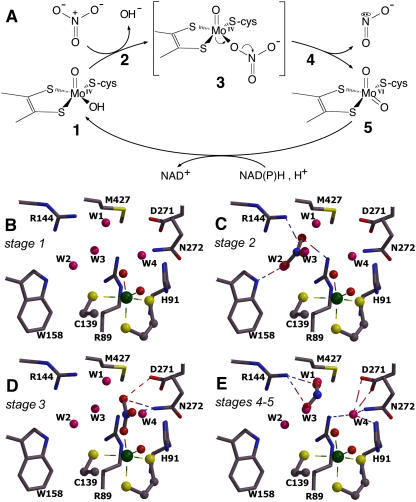Figure 6.
Hypothetical Reaction Cycle of Nitrate Reduction by NR.
(A) Reaction cycle of nitrate reduction by NR. The reaction starts with the reduced Mo(IV) center (stage 1). Nitrate binds to the active site (stage 2) and replaces the equatorial hydroxo/water ligand, thus forming the reaction intermediate (stage 3). Upon oxidation of the Mo center to Mo(VI), the bond between the nitrate oxygen and nitrogen is broken, and nitrite will be released (stages 4 and 5). After completion of the reductive half-reaction, the Mo is regenerated [Mo(IV)] for the next cycle.
(B) to (E) Models of the active site at different stages of the reaction cycle, generated with MOLSCRIPT and rendered with RASTER3D (Merritt and Murphy, 1994).
(B) View of the active site as seen in the 1.7-Å structure with four water molecules (W1 to W4) bound. The view resembles the situation shown in (A) at stage 1.
(C) Hypothetical binding of nitrate based on a superposition with W2 and W3 (stage 2 in [A]). The nitrate oxygen located at W3 attacks the Mo, and the Mo hydroxo ligand will be displaced to the position of W4.
(D) Formation of a penta-coordinated reaction intermediate with the nitrogen, nitrate-oxygen, Mo, and the apical oxygen forming a plane. The resulting hydrogen bonds of bound nitrate are indicated (stage 3 in [A]).
(E) The released nitrite is superimposed with W1 and W2 because of the high mobility of W1 (B-factor = 46).

